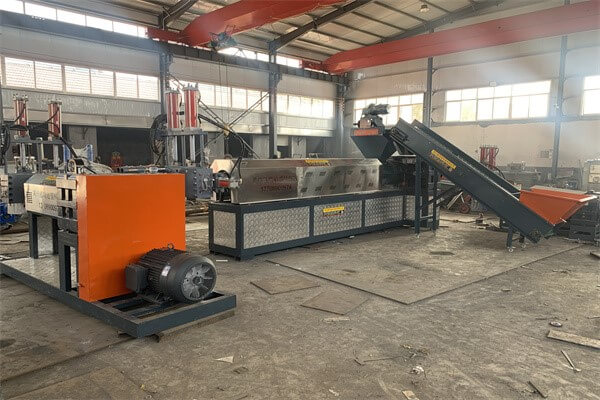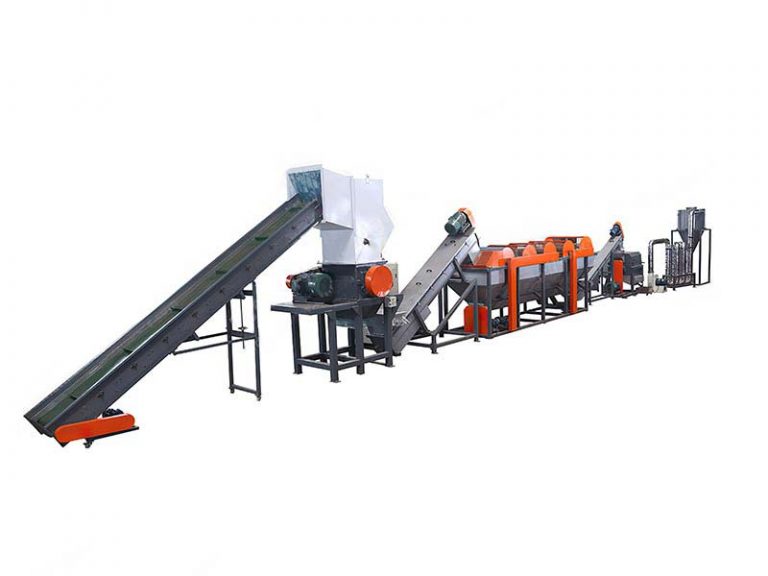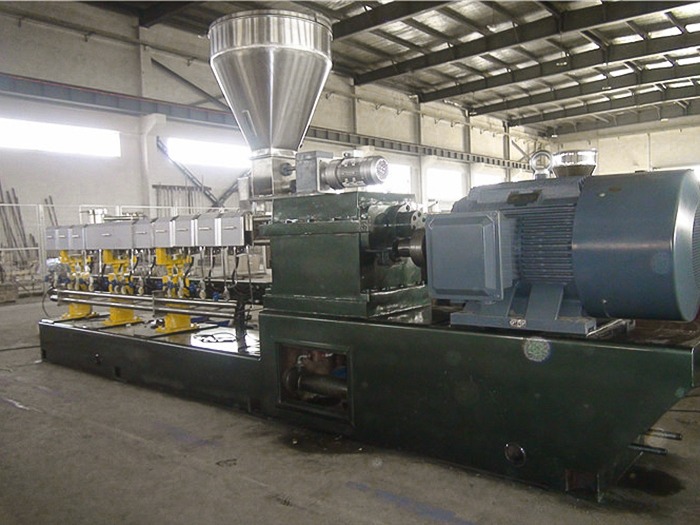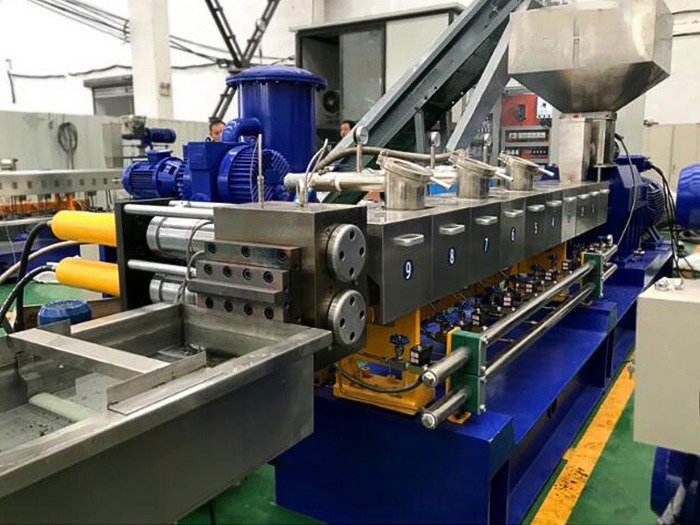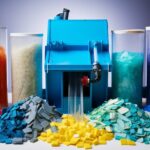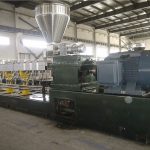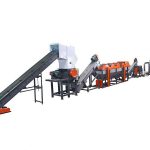Plastic pellets are an essential raw material in the production of various plastic products. In this comprehensive guide, we will explore the process of making plastic pellets from recycled plastic and discover sustainable practices for a greener future.
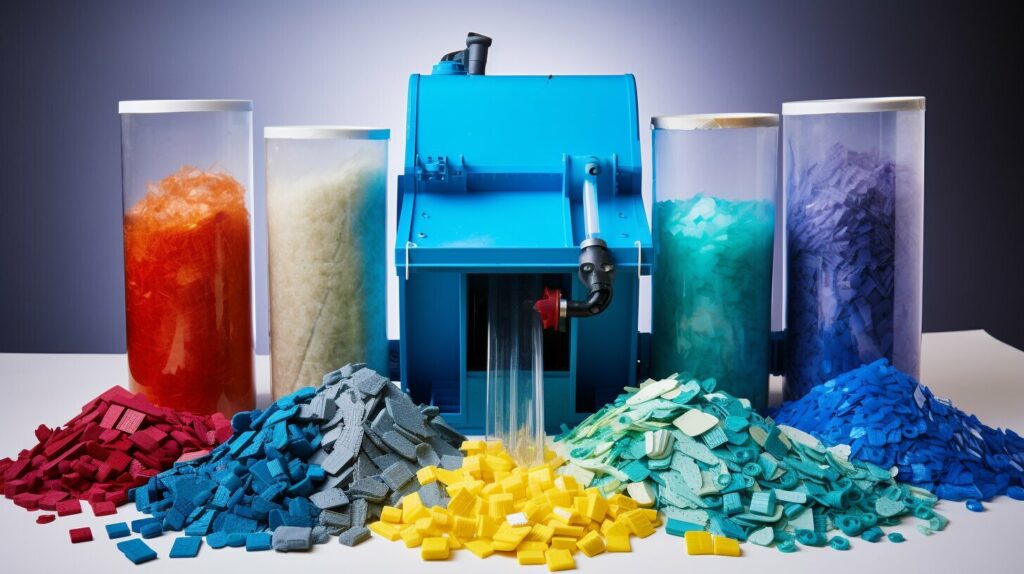
Key Takeaways:
- Making plastic pellets from recycled plastic is an effective and environmentally-friendly way to recycle plastic waste.
- The process involves collecting, sorting, crushing, washing, drying, and processing plastic waste in a recycling machine.
- An extruder plays a crucial role in melting and shaping the plastic into pellets.
- Recycled plastic pellets can be used in the production of a wide range of plastic products.
- Recycling plastic pellets reduces waste, protects the environment, and offers cost-saving benefits.
The Process of Plastic Recycling
The process of making plastic pellets from recycled plastic starts with the collection and sorting of plastic waste, followed by crushing, washing, and drying the plastic material to remove any impurities. This ensures that only clean and contaminant-free plastic is used in the pelletizing process.
Once the plastic waste is sorted and prepared, it undergoes a series of mechanical processes. First, the plastic is crushed into smaller pieces to increase its surface area and facilitate further processing. Then, it is thoroughly washed to remove dirt, grease, and any other unwanted substances. Finally, the plastic is dried to reduce moisture content, ensuring optimal conditions for the pelletizing stage.
To transform the cleaned and dried plastic material into pellets, a plastic recycling machine called an extruder is used. The extruder melts the plastic and forms it into small, uniform pellets using a die face pelletizer. The pellets are then cooled and collected for further use in the production of various plastic products.
| Steps in the Plastic Recycling Process | Description |
|---|---|
| Collection and Sorting | The plastic waste is collected and sorted based on its type and quality. |
| Crushing | The plastic waste is crushed into smaller pieces to increase its surface area. |
| Washing | The crushed plastic is thoroughly washed to remove dirt, grease, and impurities. |
| Drying | The washed plastic is dried to reduce moisture content, ensuring optimal pelletizing conditions. |
| Extrusion and Pelletizing | The cleaned and dried plastic material is fed into an extruder, where it is melted and transformed into pellets using a die face pelletizer. |
The process of plastic recycling not only helps to reduce waste and promote a circular economy but also has several environmental benefits. By reusing plastic waste, we can minimize the need for new plastic production, thereby conserving natural resources and reducing energy consumption. Additionally, recycling plastic pellets can contribute to the reduction of greenhouse gas emissions associated with the production of virgin plastic materials.
In conclusion, the process of making plastic pellets from recycled plastic is a sustainable solution to tackle plastic waste. It involves collecting, sorting, crushing, washing, and drying plastic waste, followed by extrusion and pelletizing to create new plastic pellets. By choosing recycled plastic materials, businesses can not only contribute to a greener future but also enjoy cost-saving benefits and support environmental protection efforts.
The Role of an Extruder in Pelletizing
An extruder is a key component in the process of making plastic pellets from recycled plastic, as it melts the plastic material and forms it into uniform-sized pellets using a die face pelletizer. This crucial step in the recycling process ensures that the plastic waste is transformed into a reusable form that can be used in the production of various plastic products.
During the extrusion process, the plastic waste is fed into the extruder, where it is subjected to high temperatures and pressure. The heat causes the plastic to melt, while the pressure helps to shape it into small cylindrical strands. These strands are then cut into uniform lengths by the die face pelletizer, resulting in plastic pellets that can be easily stored, transported, and used in manufacturing processes.
The extruder plays a vital role in ensuring the quality and consistency of the recycled pellets. By controlling the temperature, pressure, and speed of the extrusion process, manufacturers can produce pellets of different sizes and properties to meet specific requirements. This flexibility allows for the production of a wide range of plastic products, from industrial bags to detergent bottles and trash cans.
| Benefits of an Extruder in Pelletizing: |
|---|
| 1. Efficient melting and shaping of plastic waste |
| 2. Production of uniform-sized plastic pellets |
| 3. Controllable parameters for customized pellet production |
| 4. Versatility in manufacturing various plastic products |
By utilizing extruders in the pelletizing process, plastic manufacturers can contribute to a greener future by reducing waste, promoting recycling, and adopting sustainable practices. The use of recycled plastic pellets not only helps to conserve natural resources but also offers cost-saving benefits for businesses. With the increasing demand for eco-friendly solutions, the role of extruders in plastic pellet production is becoming more significant than ever.
Applications of Recycled Plastic Pellets
Recycled plastic pellets can be used in the production of a diverse range of plastic products, including industrial bags, detergent bottles, and trash cans, offering cost-saving benefits and contributing to waste reduction. These pellets, made from recycled plastic, provide a sustainable alternative to virgin plastic materials, ensuring a greener future for our planet.
The versatility of recycled plastic pellets makes them ideal for various applications. Industrial bags, for example, can be manufactured using these pellets, providing a durable and eco-friendly packaging solution for businesses. By utilizing recycled plastic pellets, companies can reduce their carbon footprint and demonstrate their commitment to sustainable practices.
Detergent bottles, another commonly produced item using recycled plastic pellets, benefit from the strength and durability of the material. Not only do these bottles help reduce waste by incorporating recycled plastic, but they also provide a viable solution for consumers seeking eco-friendly products.
| Plastic Product | Applications |
|---|---|
| Industrial Bags | Transportation and packaging |
| Detergent Bottles | Household cleaning products |
| Trash Cans | Waste management and recycling |
Trash cans, an essential component of waste management systems, can also be produced using recycled plastic pellets. By utilizing these pellets, companies can reduce waste and contribute to a circular economy by creating products made from recycled materials.
In conclusion, the applications of recycled plastic pellets are vast and offer a multitude of benefits. From industrial bags to detergent bottles and trash cans, the utilization of these pellets not only contributes to waste reduction but also provides cost-saving benefits for businesses. By incorporating recycled plastic materials into their production processes, companies can play a crucial role in promoting a sustainable and greener future.
Benefits of Making Plastic Pellets from Recycled Plastic
Making plastic pellets from recycled plastic not only helps reduce waste and promote recycling materials but also offers significant cost-saving benefits for businesses while contributing to environmental protection. By utilizing plastic waste that would otherwise end up in landfills or oceans, the process of creating plastic pellets from recycled plastic helps to minimize environmental pollution and conserve valuable resources.
One of the key benefits of this process is its positive impact on waste reduction. By recycling plastic waste into pellets, the amount of plastic that needs to be produced from virgin materials is significantly reduced. This not only conserves energy and natural resources but also helps to combat the growing problem of plastic waste accumulation.
In addition to waste reduction, the use of recycled plastic pellets offers considerable cost-saving advantages for businesses. By using recycled materials instead of virgin plastics, companies can save on raw material costs. Recycled plastic pellets are often more affordable than virgin plastic, making them an attractive option for manufacturers looking to reduce production expenses, improve profitability, and remain competitive in the market.
Moreover, the production and use of recycled plastic pellets contribute to environmental protection by reducing greenhouse gas emissions. The recycling process requires less energy compared to producing plastic from scratch, resulting in a lower carbon footprint. By choosing recycled plastic pellets, businesses can play an active role in supporting sustainability initiatives and working towards a greener future.
To summarize, making plastic pellets from recycled plastic offers a multitude of benefits. It helps reduce waste, promotes the use of recycled materials, provides cost-saving advantages for businesses, and contributes to environmental protection. By embracing this sustainable practice, companies can not only make a positive impact on the planet but also position themselves as responsible and forward-thinking leaders in their industry.
Conclusion
The process of making plastic pellets from recycled plastic plays a vital role in plastic recycling, promoting sustainable practices, and working towards a greener future. By using recycled plastic pellets, businesses can reduce waste, save costs, and contribute to environmental protection.
Making plastic pellets begins with collecting and sorting plastic waste, followed by crushing, washing, and drying the plastic. The dried waste is then processed in a plastic recycling machine, such as a two-stage recycling machine, which cuts and compacts the waste. The compacted waste is fed into an extruder, a machine that melts the plastic material and forms it into pellets using a die face pelletizer.
These recycled plastic pellets are incredibly versatile and can be used in the production of various plastic products, including industrial bags, detergent bottles, and trash cans. By utilizing recycled pellets instead of virgin plastic, businesses not only reduce waste but also help protect the environment.
In addition to the environmental benefits, using recycled plastic pellets also offers cost-saving advantages for businesses. By utilizing recycled materials, companies can reduce production costs and contribute to a more circular economy.
Summary
In summary, the process of making plastic pellets from recycled plastic is an effective and sustainable way to recycle plastic waste. By using recycled pellets, businesses can contribute to reducing waste, saving costs, and protecting the environment. It is crucial for plastic manufacturers to adopt sustainable practices and work towards a greener future.
FAQ
What are plastic pellets?
Plastic pellets are small granules used in the production of various plastic products.
How are plastic pellets made from recycled plastic?
The process involves collecting and sorting plastic waste, crushing it, washing it to remove dirt and grease, and drying it. The dried plastic waste is then processed in a plastic recycling machine, such as a two-stage recycling machine, which cuts and compacts the waste before feeding it into an extruder. The extruder melts the plastic and forms it into pellets using a die face pelletizer.
What can be made from recycled plastic pellets?
Recycled plastic pellets can be used to create a wide range of products such as industrial bags, detergent bottles, trash cans, and more.
Why is making plastic pellets from recycled plastic important?
Making plastic pellets from recycled plastic reduces waste, helps protect the environment, and offers cost-saving benefits for businesses.
How does the process of plastic recycling work?
The process involves collecting and sorting plastic waste, crushing it, washing it to remove dirt and grease, and drying it. The dried plastic waste is then processed in a plastic recycling machine, such as an extruder, which melts the plastic and forms it into pellets.
Can all types of plastic be recycled into pellets?
No, not all types of plastic can be recycled into pellets. Different types of plastic have different chemical compositions and melting points. However, many common plastics such as HDPE (high-density polyethylene) and PE (polyethylene) can be easily recycled and transformed into pellets.
How can I make plastic pellets from plastic waste at home?
Making plastic pellets from plastic waste at home can be a complex and potentially dangerous process. It requires specialized equipment such as an extruder and a pelletizer. It is recommended to leave the plastic pelletization process to professional recycling facilities or use local recycling programs for proper disposal of plastic waste.
Are plastic pellets made from recycled plastic as good as those made from virgin plastic?
Plastic pellets made from recycled plastic can be just as good as those made from virgin plastic, depending on the quality of the recycling process. However, it’s important to note that recycled plastic may have slightly different properties compared to virgin plastic, which can affect certain characteristics of the final plastic product.

